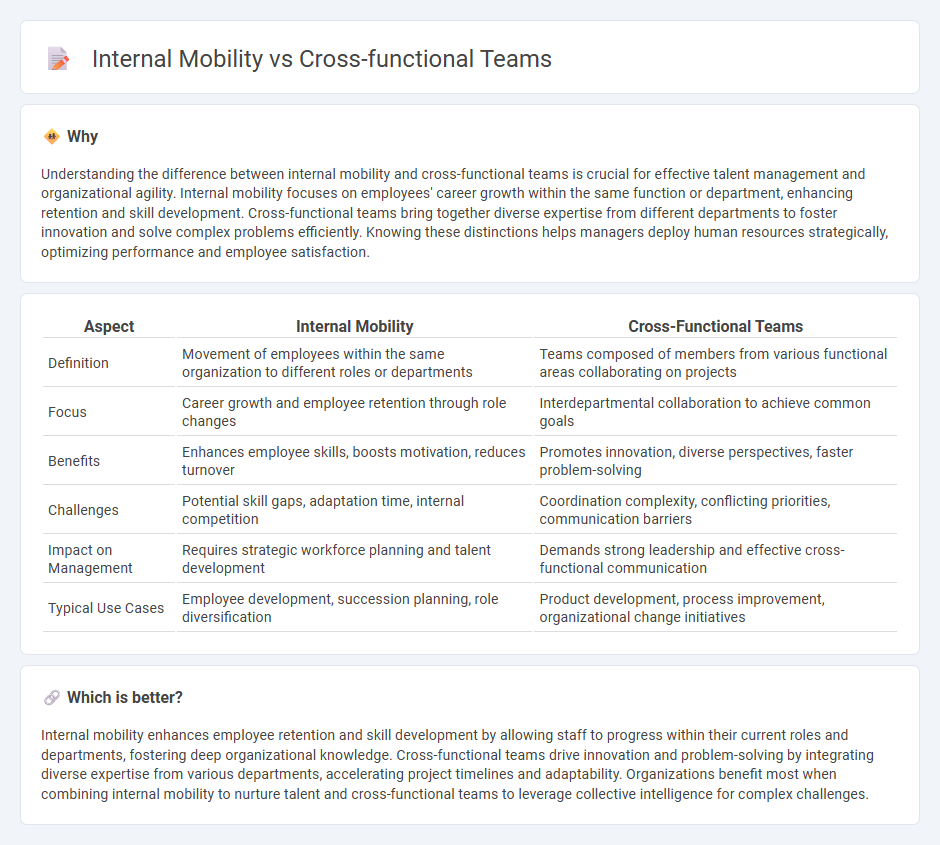
Internal mobility enhances employee retention by promoting career growth within the organization, while cross-functional teams drive innovation through diverse skill sets collaborating toward shared goals. Both strategies optimize talent utilization and improve organizational agility in dynamic markets. Discover how leveraging internal mobility and cross-functional teams can transform your management approach.
Why it is important
Understanding the difference between internal mobility and cross-functional teams is crucial for effective talent management and organizational agility. Internal mobility focuses on employees' career growth within the same function or department, enhancing retention and skill development. Cross-functional teams bring together diverse expertise from different departments to foster innovation and solve complex problems efficiently. Knowing these distinctions helps managers deploy human resources strategically, optimizing performance and employee satisfaction.
Comparison Table
| Aspect | Internal Mobility | Cross-Functional Teams |
|---|---|---|
| Definition | Movement of employees within the same organization to different roles or departments | Teams composed of members from various functional areas collaborating on projects |
| Focus | Career growth and employee retention through role changes | Interdepartmental collaboration to achieve common goals |
| Benefits | Enhances employee skills, boosts motivation, reduces turnover | Promotes innovation, diverse perspectives, faster problem-solving |
| Challenges | Potential skill gaps, adaptation time, internal competition | Coordination complexity, conflicting priorities, communication barriers |
| Impact on Management | Requires strategic workforce planning and talent development | Demands strong leadership and effective cross-functional communication |
| Typical Use Cases | Employee development, succession planning, role diversification | Product development, process improvement, organizational change initiatives |
Which is better?
Internal mobility enhances employee retention and skill development by allowing staff to progress within their current roles and departments, fostering deep organizational knowledge. Cross-functional teams drive innovation and problem-solving by integrating diverse expertise from various departments, accelerating project timelines and adaptability. Organizations benefit most when combining internal mobility to nurture talent and cross-functional teams to leverage collective intelligence for complex challenges.
Connection
Internal mobility drives the formation of cross-functional teams by enabling employees to move across departments, enhancing skill diversity and collaboration. Cross-functional teams benefit from internal mobility as it provides access to a broader talent pool with varied expertise, fostering innovation and agility in management. This dynamic supports organizational adaptability, ensuring teams are composed of members with complementary skills aligned to evolving business needs.
Key Terms
Collaboration
Cross-functional teams enhance collaboration by bringing together diverse expertise from different departments, which promotes innovation and problem-solving through varied perspectives. Internal mobility supports collaboration by enabling employees to rotate roles, fostering knowledge sharing and building stronger interpersonal networks across teams. Explore strategies to leverage both approaches for maximizing organizational collaboration efficiency.
Talent Development
Cross-functional teams enhance talent development by promoting diverse skill sets, collaboration, and innovation across departments, while internal mobility focuses on career progression within the organization through role changes and promotions. Both strategies improve employee engagement and retention by fostering professional growth and adaptability, but cross-functional teams emphasize project-based learning, whereas internal mobility prioritizes long-term career pathways. Explore how integrating both approaches can maximize talent development in your organization.
Resource Allocation
Cross-functional teams enhance resource allocation by integrating diverse expertise from various departments, leading to more innovative solutions and efficient project execution. Internal mobility optimizes resource allocation by repositioning existing talent within the organization, reducing hiring costs and accelerating knowledge transfer. Explore how strategic resource allocation can be maximized by balancing cross-functional collaboration and internal mobility initiatives.
Source and External Links
What Are Cross-Functional Teams? (Benefits and Examples) - Cross-functional teams consist of individuals from various departments collaborating to achieve a specific project or initiative, enhancing organizational success and efficiency.
Cross-Functional Team | Definition, Collaboration & Examples - A cross-functional team combines people with different functional expertise to achieve a common goal, leveraging synergy to enhance results.
Cross-functional team - Wikipedia - Cross-functional teams involve people from different functional areas working together toward a shared objective, often requiring strategic, tactical, and operational information.
 dowidth.com
dowidth.com